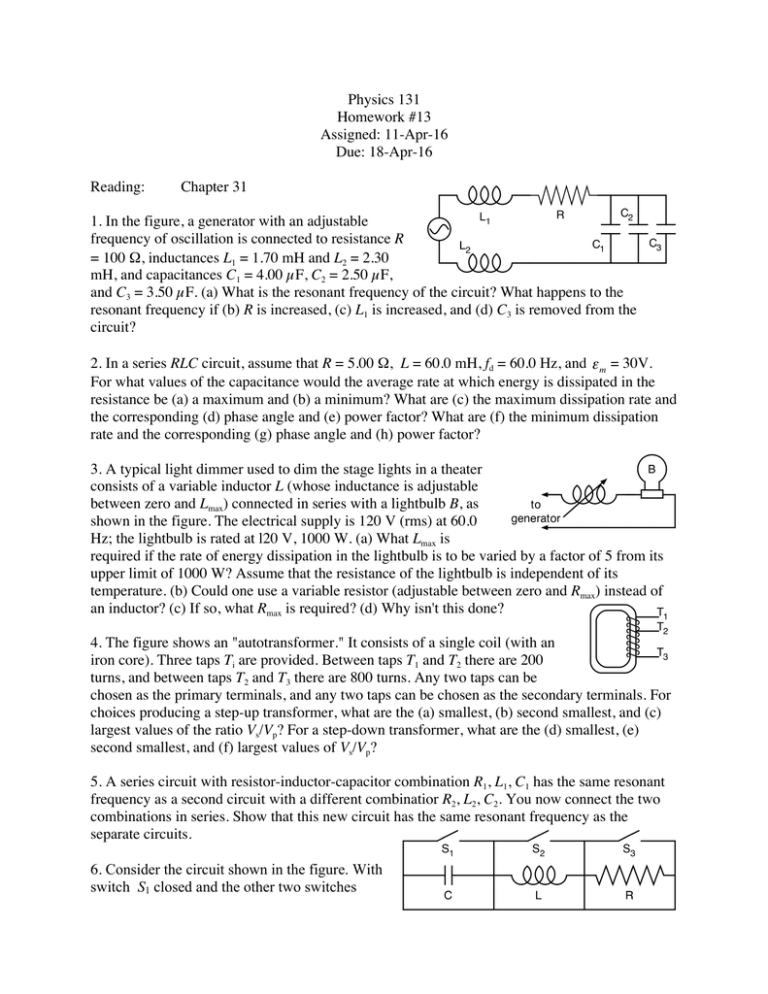Physics 131 Homework #13 Assigned: 11-Apr-16 Due: 18-Apr
advertisement

Physics 131 Homework #13 Assigned: 11-Apr-16 Due: 18-Apr-16 Reading: Chapter 31 1. In the figure, a generator with an adjustable frequency of oscillation is connected to resistance R = 100 Ω, inductances L1 = 1.70 mH and L2 = 2.30 mH, and capacitances C1 = 4.00 µF, C2 = 2.50 µF, and C3 = 3.50 µF. (a) What is the resonant frequency of the circuit? What happens to the resonant frequency if (b) R is increased, (c) L1 is increased, and (d) C3 is removed from the circuit? 2. In a series RLC circuit, assume that R = 5.00 Ω, L = 60.0 mH, fd = 60.0 Hz, and = 30V. For what values of the capacitance would the average rate at which energy is dissipated in the resistance be (a) a maximum and (b) a minimum? What are (c) the maximum dissipation rate and the corresponding (d) phase angle and (e) power factor? What are (f) the minimum dissipation rate and the corresponding (g) phase angle and (h) power factor? 3. A typical light dimmer used to dim the stage lights in a theater consists of a variable inductor L (whose inductance is adjustable between zero and Lmax) connected in series with a lightbulb B, as shown in the figure. The electrical supply is 120 V (rms) at 60.0 Hz; the lightbulb is rated at l20 V, 1000 W. (a) What Lmax is required if the rate of energy dissipation in the lightbulb is to be varied by a factor of 5 from its upper limit of 1000 W? Assume that the resistance of the lightbulb is independent of its temperature. (b) Could one use a variable resistor (adjustable between zero and Rmax) instead of an inductor? (c) If so, what Rmax is required? (d) Why isn't this done? 4. The figure shows an "autotransformer." It consists of a single coil (with an iron core). Three taps Ti are provided. Between taps T1 and T2 there are 200 turns, and between taps T2 and T3 there are 800 turns. Any two taps can be chosen as the primary terminals, and any two taps can be chosen as the secondary terminals. For choices producing a step-up transformer, what are the (a) smallest, (b) second smallest, and (c) largest values of the ratio Vs/Vp? For a step-down transformer, what are the (d) smallest, (e) second smallest, and (f) largest values of Vs/Vp? 5. A series circuit with resistor-inductor-capacitor combination R1, L1, C1 has the same resonant frequency as a second circuit with a different combinatior R2, L2, C2. You now connect the two combinations in series. Show that this new circuit has the same resonant frequency as the separate circuits. 6. Consider the circuit shown in the figure. With switch S1 closed and the other two switches open, the circuit has a time constant τc. With switch S2 closed and the other two switches open, the circuit has a time constant τL.With switch S3 closed and the other two switches open, the circuit oscillates with a period T.Show that T = 2π (τCτL)1/2. 7. The ac generator in the figure supplies 120V at 60.0 Hz. With the switch open as in the diagram, the current leads the generator emf by 20.0°. With the switch in position 1, the current lags the generator emf by 10.0°. When the switch is in position 2, the current amplitude is 2.00A. What are (a) R, (b) L and (c) C? 8. A series RLC circuit is driven by a generator at frequency 1050 Hz.The inductance is 90.0 mH; the capacitance is 0.500 µF; and the phase constant has a magnitude of 60.0° (you should supply the appropriate sign for the angle). (a) What is the resistance? To increase the current amplitude in the circuit, should we increase or decrease (b) the driving frequency, (c) the inductance, and (d) the capacitance? 9. In a series oscillating RLC circuit, R = 16.0 Ω, C = 31.2 µF, L = 9.2 mH and ε = εm sin ωdt with εm = 45.0 V and ωd = 3000 rad/sec. For time t = 0.442 ms find (a) the rate PG at which energy is being supplied by the generator, (b) the rate PC at which the energy in the capacitor is changing, (c) the rate PL at which the energy in the inductor is changing, and (d) the rate PR at which energy is being dissipated in the resistor. (e) Is the sum of PC, PL and PR greater than, equal to or less than PG? 10. The fractional half-width, ∆ωd of a current resonance curve, I vs ωd, is the width of the curve at half of its maximum value. Show that ∆ωd/ω = R(3C/L)1/2, where ω is the angular frequency at current resonance. Note that ∆ωd/ω increases with R.


